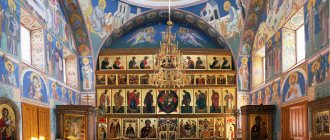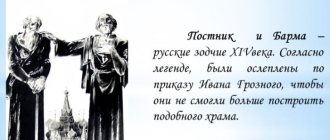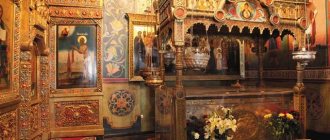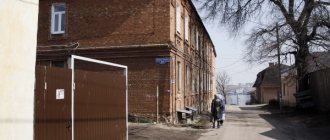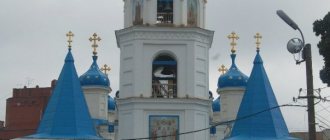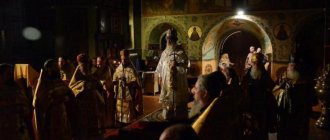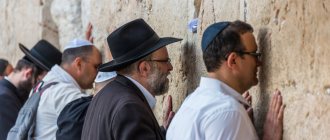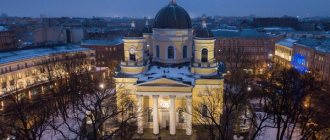St. Basil's Cathedral - real name
St. Basil's Cathedral is a cult building from the time of Ivan the Terrible, by which any foreigner still recognizes Moscow.
This is the most recognizable Russian temple. Few people know its true name - the Cathedral of the Intercession of the Virgin Mary on the Moat. On July 2 (June 29, old style), 1561, the central Intercession Church of the cathedral was once consecrated. The first reliable mention of the construction of the Church of the Intercession of Our Lady dates back to the autumn of 1554. It is believed that it was a wooden cathedral, which was later demolished to build a stone church. The reason for the construction of the cathedral was the conquest of the Kazan Khanate.
Tsar Ivan the Terrible, praying before the start of a military campaign, made a vow to God to build a temple, which Rus' had never seen before, in the event of his victory. The king was harsh and merciless, but remained a deeply religious man.
LiveInternetLiveInternet
Each capital has its own symbol, by which it is unmistakably recognizable. For Moscow, this is the Intercession Cathedral on Red Square, better known as St. Basil's Cathedral. The building, which looks like a precious box, cannot be confused with any other because of the amazing silhouette formed by the heads of nine churches erected on a single foundation, and the unique, colorful and joyful design of their facades...
Any work of art, man-made or miraculous miracle is surrounded by an aura of mystery. Take Leonardo’s “La Gioconda,” Mozart’s “Requiem,” the Great Pyramids, Lake Baikal or the Grand Canyon. What kind of miracle is this if legends are not made about it? If it doesn’t make you want to learn more about it and, when there is not enough information, start making guesses that eventually turn into legends?
Cathedral of the Intercession of the Mother of God (Cathedral “What’s on the Moat” or St. Basil’s Cathedral).
In this, as in many other respects, St. Basil's Cathedral is a true, one hundred percent miracle - what stories are told about it! But, it would seem, everything should be known for certain about the building erected on the central square of the capital. But no, that was not the case...
It is believed that the Church of the Intercession was built in 1555-1561 by Russian architects Barma and Postnik Yakovlev. Although there is a hypothesis that it was one master - Ivan Yakovlevich Barma.
There is a well-known legend that when Ivan the Terrible asked whether the craftsmen could build another, equally beautiful temple, one of them defiantly answered: “We can!” - and thus angered the king. "You're lying!" - cried the Terrible and ordered the masters to be blinded so that they would not build such a miracle anywhere else. Similar stories, however, are told about many Russian and foreign councils, so they are hardly worth believing.
Another legend says that Ivan the Terrible built this temple in honor of his father, Grand Duke Vasily III: “People will remember me even without churches for a thousand years, but I want my parent to be remembered.” This is supposedly where the name of the temple came from.
In honor of another Vasily
Initially, on the edge of the Moscow River, on a hill next to the moat that surrounded the medieval Kremlin and was filled in in the 19th century, there stood a white stone temple in the name of the Life-Giving Trinity, where the most revered holy fool in Rus', St. Basil the Blessed, was buried. Then, by order of Tsar Ivan the Terrible and with the blessing of Metropolitan Macarius, new churches began to be built around it, most of which were consecrated in memory of the events of the Kazan campaign.
The complex that grew up on the site of the former temple was called the Cathedral of the Intercession of the Virgin Mary, in common parlance - the Church of the Intercession on the Moat
At the end of the 16th century, on the site of the dismantled north-eastern part of the gallery above the grave of the Moscow holy fool, canonized Saint Basil, a church appeared, consecrated in his name. Unlike the churches of the Intercession Cathedral, where services were held on the days of the twelfths and patronal feasts, in the Church of St. Basil the Blessed the service was daily. This was the reason for the appearance of the popular name for the Intercession Cathedral - St. Basil's Cathedral.
This temple was the geometric center of the capital's urban planning ensemble, and its 46-meter tent was the tallest in Moscow until Boris Godunov ordered the construction of the bell tower of the Kremlin Church of St. John the Climacus to 81 meters, after which it began to be called Ivan the Great.
Briefly about the main thing
St. Basil's Cathedral is a symmetrical ensemble of eight pillar-shaped churches surrounding the ninth, the tallest, crowned with a tent. The central church is dedicated to the Feast of the Intercession of Our Lady - it was on this day that Kazan was taken by storm.
The chapels are connected to each other by a system of transitions. The pillar-shaped churches are topped with onion domes, none of which is identical in architectural decoration to the others. Each dome is decorated with cornices, kokoshniks, windows and niches. In general, the cathedral creates a feeling of festivity and elegance. In total there are 9 iconostases, which contain about 400 icons of the 16th-19th centuries, representing the best examples of the Novgorod and Moscow icon painting schools.
The walls of the cathedral are decorated with oil paintings and frescoes of the 16th-19th centuries. In addition to icons, the cathedral displays portrait and landscape paintings and church utensils. Among the particularly valuable exhibits is a 17th-century chalice that belonged to Tsar Alexei Mikhailovich.
We protect people and God
According to Orthodox priests, St. Basil's Cathedral was preserved by the special providence of God - more than once it found itself on the brink of destruction and yet remained intact.
In 1737, the Intercession Church was badly damaged by a fire, but was restored and, according to eyewitnesses, became even more beautiful. Having seen it, Napoleon, according to legend, ordered to transport the Moscow miracle to Paris, but the technology of that time was unable to solve this problem. Then, before the retreat of the French army, Napoleon ordered the temple to be blown up along with the Kremlin. Muscovites tried to extinguish the lit fuses, and suddenly pouring torrential rain helped them stop the explosion.
Among others, there is a legend that in 1936 Lazar Kaganovich proposed demolishing the Intercession Cathedral to clear space for festive demonstrations and traffic on Red Square. By his order, a model of Red Square with a removable Intercession Church was made, which Kaganovich brought to Stalin. Starting with a story about how the cathedral interferes with demonstrations and cars, he allegedly with the words “What if it was - r-time!..” - he jerked the temple from the square. Stalin looked, thought and slowly uttered the famous phrase: “Lazarus! Put it in its place!”
The question of demolishing the temple was indeed raised, but, according to a number of historians, the courage of the architect P.D. played the main role in its decision. Baranovsky. When he was ordered to prepare the temple for demolition, he flatly refused and threatened to commit suicide, and then sent a harsh telegram to the Kremlin: to the Central Committee and, as usual, personally to Comrade Stalin.
According to one version, the letter reached the addressee, and Baranovsky, being invited to the Kremlin, knelt before the assembled Central Committee, begging not to destroy the temple. It is unlikely that this was exactly what had an effect, but one way or another, something really stopped Stalin - the decision to demolish it was canceled.
Everything returns to normal...
According to one of the official versions, and there are also several of them, in 1918 the Intercession Cathedral was one of the first to be taken under state protection as a monument of national and world significance. Since May 21, 1923, it has been open to visitors as a historical and architectural museum. Moreover, until 1929, services were held in the Church of St. Basil the Blessed.
Then the cathedral became a branch of the State Historical Museum. Scientific restoration research began, thanks to which it became possible to restore the original appearance of the cathedral and recreate the interiors of the 16th-17th centuries in individual churches. Since then, four global restorations have been carried out, including architectural and painting works.
In the 60s of the 20th century, during restoration work, a temple chronicle was discovered, in which the builders indicated the exact date of completion of the cathedral - July 12, 1561 (Peter's Day); The iron coverings of the domes of the cathedral churches were replaced with copper ones.
In the 70s, during restoration, a spiral wooden staircase was discovered in the wall. This is how museum visitors now get to the central temple, where they can see the magnificent tent soaring into the sky and the most valuable iconostasis, as well as walk through the narrow labyrinth of the internal gallery, painted with marvelous patterns.
The Intercession Cathedral is federal property. Since 1990, it has been used both as a museum and as a temple in which the Russian Orthodox Church holds services.
https://www.softmixer.com
St. Basil's Cathedral - history
In order to preserve the beautiful building in a single copy, Tsar Ivan the Terrible ordered the architects Postnik and Barma to be blinded, so the legend says. Their names became known only at the end of the 19th century. It is believed that the king watched the construction of the temple from a tower on the Kremlin wall. When construction came to an end, he called the architects to him to ask if they could repeat such a building? The architects answered the king in the affirmative. Then he ordered to deprive them of their sight. Scientists also have doubts about this: in the 16th century, outstanding architects were highly valued. So Italian craftsmen were invited to build the Kremlin. It is quite possible that, knowing the harsh disposition of the Russian Tsar, foreigners spread the rumors.
In the XVIII-XIX centuries. Divine services were regularly held in St. Basil's Cathedral. As a rule, they were performed in the annex - a church built in honor of St. Basil the Blessed, because the other churches were cold. That is why the name has taken root among the people - St. Basil's Cathedral.
Divine services in the temple continued until the beginning of the 20th century. The last rector was Father John Vostorgov, now canonized among the host of new martyrs and confessors. He was shot for missionary activity. He enjoyed special love and respect among Muscovites.
“At the request of Father John, the executioners allowed all the condemned to pray and say goodbye to each other. Everyone knelt down, and fervent prayer poured out... And then everyone said goodbye to each other. The first to cheerfully approach the grave was Archpriest Vostorgov, who had previously said a few words to the others, inviting everyone, with faith in God’s mercy and the speedy revival of the Motherland, to make the final atoning sacrifice. “I’m ready,” he concluded, turning to the convoy. Everyone stood in the indicated places. The executioner came close to him from behind, took his left hand, twisted him by the lower back and, putting a revolver to the back of his head, fired, at the same time pushing Father John into the grave.”
During the Great Patriotic War, the museum did not stop its work, although it was closed to visitors. St. Basil's Cathedral was carefully camouflaged to protect it from bombing. There is a legend that after the war, Stalin was offered to remove the cathedral under the pretext of interfering with the parade. It is believed that Kaganovich showed Stalin a model of the square, and in his presence removed the model of the temple, offering to demolish it. Stalin abruptly interrupted him: “Lazarus, put him in his place!” Since then, no one has questioned the integrity of the cathedral.
Churches of St. Basil's Cathedral
Church of the Intercession of the Blessed Virgin Mary
The central chapel of St. Basil's, from which the cathedral received its official name. You can discover the true scale of the cathedral from inside the central church. In some areas the original brickwork and paintings remain, including an inscription with the date of completion (12 July 1561), illuminated by a magnificent chandelier. The huge Baroque iconostasis was brought to Moscow in the late 1700s.
Church of Cyprian and Justina
The chapel was consecrated in honor of the martyrs Cyprian and Justina, whose memorial day marks the capture of Kazan on October 2, 1552. White columns flanking the octagonal chapel frame bold frescoes depicting the lives of saints and extend to the central fresco of Our Lady. The gilded iconostasis in classical style depicts scenes of Creation. The Church of Cyprian and Justina is crowned with a blue and white dome with vertical stripes.
Church of St. Gregory of Armenia
One of four small chapels dedicated to Saint Gregory, who was responsible for the conversion of Armenia to Christianity. The destruction of the Arsk tower of the Kazan fortress in 1552, a key moment in the campaign of Ivan the Terrible, occurred on Saint's Day (September 30).
The austere whitewashed walls are offset by a bright iconostasis draped with silk and velvet curtains. Also visible are 16th-century architectural features, 17th-century religious clothing, traditional candles and an elegant enamel lamp. The outer dome is decorated with a grid of yellow diamonds.
Church of the Three Patriarchs of Constantinople
The memory of Patriarchs Alexander, John and Paul is celebrated on August 30 - the day when the troops of Ivan the Terrible defeated the Tatar prince Yapanchi in 1552. Oil paintings adorning the walls and ceiling depict patriarchs and other religious figures, and the huge five-tier iconostasis consists of baroque and classical elements. Another of the cathedral's smaller chapels, its dome is made of green and red diamonds.
Church of St. Basil (St. Basil)
The smallest chapel in the ensemble, but perhaps the most richly decorated, with colorful frescoes depicting religious figures and scenes from the life of St. Basil. The construction of the iconostasis was supervised by the famous artist Osip Chirikov. It is so large that it stretches along the adjacent walls, and its icons are placed on a gold, red and blue background. Two ancient icons are especially noteworthy: the Smolensk Mother of God and the image of St. Basil the Blessed. The canopy over the resting place of St. Basil is one of the most revered shrines in Moscow.
Church of the Entry of the Lord into Jerusalem
This church celebrates Jesus' entry into Jerusalem, otherwise known as Palm Sunday. The solemn whitewashed walls are decorated with original 16th-century features, and above the north door, visitors can see damage caused by artillery shelling during the October Revolution. The iconostasis of this church was taken from the Kremlin's Alexander Nevsky Cathedral and depicts scenes from the life of this great Russian hero. The dome of the church is decorated with green and red carnations.
Holy Trinity Church
This church honors the basic teachings of Christianity. Its interior is light, elegant and peaceful, and the original architecture and decoration are almost entirely preserved, including the cathedral's oldest candelabra and one of its most revered icons, the Old Testament Trinity. Cream and green stripes curve toward the top of the dome, reflecting the eternity spiral that adorns the inside of the dome. Interestingly, the acoustics of the chapel are complemented by clay vessels inlaid into the walls.
Church of Alexander Svirsky
This small chapel celebrates Saint Alexander of Svirsky, who was responsible for converting Northern Rus' to Orthodoxy. The saint's memorial day is celebrated on August 30. The interior of the chapel is covered with frescoes imitating brickwork, and an eternity spiral winds around the inner dome. The outer part consists of green and cream curved stripes.
Church of St. Nicholas the Wonderworker
A large church dedicated to St. Nicholas the Wonderworker, whose revered icon was sent from Vyatka to Moscow in 1555. This event of great spiritual significance is illustrated by frescoes, and the iconostasis of the temple depicts the life of St. Nicholas. The decoration of the chapel is especially rich: colorful paintings reach the ceiling, and the iconostasis is decorated with floral motifs in gilded stucco. The outer dome is covered with red and white zigzag stripes.
Church of Varlaam Khutynsky
Another small chapel of the cathedral, topped with a dome of green and yellow triangles. It glorifies Saint Varlaam of Khutyn, an ascetic revered by Ivan IV and his father as the patron saint of the imperial family. Saint's Day, November 6, marks Ivan's victorious return to Moscow in 1552.
The iconostasis is decorated with icons of the 16th-18th centuries, and of particular interest is the large hanging icon - the vision of Sexton Tarasius, depicting the prediction of a number of disasters that befell Novgorod. This icon is fascinating because it is the first work in the history of ancient Russian art that depicts an entire city. Novgorod is depicted with amazing topographical accuracy.
Church of St. John the Blessed
The eleventh and last church of the cathedral ensemble, reopened to visitors only in November 2021. The chapel was consecrated in honor of St. John, the Fool for Fool, and contains a gilded iconostasis, the relics of the saint, and a small display of religious objects and works of art.
St. Basil's Cathedral - architecture
The cathedral was built over 6 years from 1555 to 1561. Its original image was changed by extensions, but the idea of St. Basil's Cathedral seems unusual even in modern times. It looks like a vault of eight churches that surrounds the tallest one, the ninth. A similar temple still does not exist in Russia. Each temple has its own entrance and lighting, however, the cathedral is a single building.
Without the attached porches, St. Basil's Cathedral seemed to be moving upward. The craftsmen used all possible architectural decorations at that time. All the domes of the cathedral are similar, but made differently. Nevertheless, the building looks very harmonious. This is one of the unique features of the cathedral. The idea of particular differences with general similarity also dominates the interior design of the cathedral. There are a lot of sacred symbols in the architecture of the cathedral: a circle is a symbol of eternity, a triangle is a symbol of the trinity of God, a square reminds of equality and justice, and a dot is the beginning of life. The architecture of the cathedral contains enormous spiritual meaning.
The thickness of the walls of the base of St. Basil's Cathedral reaches three meters. It is this thickness that allows you to securely hold as many as nine buildings. If you look at the base of the church, you can see that 8 small churches form an eight-pointed star - a symbol of the Virgin Mary. In the ensemble of small churches there are larger churches. They are strictly oriented to the cardinal directions and form symmetry. The main temple, with a huge dome and tent, represents the Protection of the Virgin Mary, Her intercession.
Background to the construction of the cathedral
St. Basil's Cathedral is not the first construction of a religious shrine to arise in Moscow in the 16th century. Initially, wooden churches were erected in honor of saints or Orthodox holidays that fell on the day of some military event on Kazan land, when Tsar Ivan the Terrible was fighting the Tatar invasion. One of the great battles, which took place on October 2, 1552, ended with a complete victory over the Kazan Khanate and the annexation of the city’s lands to the Orthodox city of Moscow.
This date (October 1) falls on the religious holiday of the Intercession of the Blessed Virgin Mary, which gave rise to the construction of a cathedral in memory of the final victory, which was consecrated in honor of the Intercession of the Virgin Mary. But the day of the campaign and victory itself coincided with another Orthodox day - the veneration of Saints Cyprian and Justina.
By decree of Ivan the Terrible, it was decided to combine all the camp churches erected on Red Square earlier and the new temple into a cathedral, which should become stone. But upon returning to Moscow, a wooden cathedral with seven chapels was built. It was consecrated in the name of the Intercession of the Most Holy Theotokos. Only a year later the wooden buildings were dismantled and the construction of a stone church began, but it still had nothing to do with the name of St. Basil.
Reasons for the founding of the temple
St. Basil's Cathedral, among other buildings of the Intercession Church, appeared only in 1588 and became the 9th church of a unique monument of the Orthodox faith. The reasons for the construction of St. Basil's Cathedral were the events that took place during the reign of Ivan Vasilyevich the Terrible and his son Fyodor Ivanovich. According to legends, Vasily was a holy fool and collected alms on Red Square, from which he fed and lived. He dressed in rags or went without any clothes even in the bitter cold. He wore chains as a symbol of repentance and sacrificing himself for the sake of Christ. He had the gift of healing and foresight, as evidenced by various legends or descriptions of his life.
Ivan the Terrible treated the holy fool with special respect and after his death, the date of which is twofold (1552 or 1557), permission was given to bury the body near the walls of the Intercession Church. According to chronicle documents, several years after the death of Basil, several healings were recorded from his relics, which was the reason for erecting a shrine made of precious metal with expensive stones over the grave of St. Basil and building a church, which was consecrated in honor of this saint.
Tsar Fyodor Ivanovich set the date for the veneration of the name of St. Basil - August 2, the day of the miraculous healing.
Unlike other churches that were part of the ensemble of churches of the Intercession of the Blessed Virgin Mary, St. Basil's Cathedral was an independent building and had a separate entrance.
There are two versions of the reasons for the construction of a multi-aisle temple:
- The Intercession Cathedral was supposed to become a semblance of the Vlachensky Monastery, in which the miracle of the Intercession of the Most Holy Theotokos was revealed. It has a seven-tower shape. The Intercession Cathedral in Moscow was supposed to commemorate the ideology of the state of that time, that Moscow is the Third Rome.
- The idea of a multi-aisled cathedral was proposed by Metropolitan Macarius, who wanted to build another city in the center of Moscow, symbolizing Jerusalem, so to speak, a city within a city, which also echoed the concept of the Third Rome. The Cathedral of the Intercession of the Most Holy Theotokos is the Heavenly Jerusalem and it must be indivisible, which is why all the buildings were erected on a single foundation.
Regardless of what idea led to the creation of a religious shrine, it is an object of unique Orthodox architecture, which still inspires admiration among people.
How the cathedral was built: versions
There are several versions about the construction of the cathedral, the ensemble of buildings of which includes St. Basil's Cathedral, who is the architect of the project and what their fate was after the completion of the work.
Two versions put forward the following names as the authors of the masterpiece: Postnik and Barma. The confusion lies in whether it is one person or two different ones.
- One version suggests that Ivan the Terrible invited an architect from Pskov to implement his idea. His name was Postnik Yakovlev, but the people had the nickname Barma. This indicates that one person created the design of the Intercession Church and supervised its construction.
- The second version comes down to the fact that Postnik and Barma are two different people who jointly brought the idea of a multi-altar cathedral to life.
- The third version has nothing to do with Postnik or Barma. It is assumed that the author of the project was a European architect, presumably Italian. The style of the temple is very similar to the motifs of the Moscow Kremlin, the construction of which was carried out by the European architect. But there is no documentary evidence of this version.
The official version is considered to be the second assumption, that there were two architects.
St. Basil's Cathedral - the idea
This choice of the architects is due to the fact that, according to the idea, St. Basil's Cathedral was supposed to symbolize paradise, the city of the Lord. The idea belonged to Metropolitan Macarius, and the architects tried to bring it to life. Epochs changed, and along with them, people’s ideas about what heaven should look like changed, and therefore the cathedral underwent changes. The main idea remained unchanged: St. Basil's Cathedral is a prototype of a heavenly paradise, a blossoming garden. It is decorated with grape leaves, beautiful flowers, plants that do not grow on the ground...
Interior of St. Basil's Cathedral
St. Basil's Cathedral fascinates with the variety of architectural and artistic styles present in the interior. Among the wonders that can be found inside the cathedral are oil paintings, frescoes, portraits and landscape paintings. Also iconostases containing more than 400 masterpieces of Moscow and Novgorod icon painting of the 16th-19th centuries. And also valuable exhibits belonging to the church and the imperial family.
The cathedral's chapels are connected by a labyrinth of vaulted interior passages and galleries, which are decorated from floor to ceiling with colorful geometric patterns and natural motifs.
St. Basil's Cathedral - our days
In St. Basil's Cathedral you can now see paintings from different centuries: the 17th and 19th centuries are adjacent. This is an amazing architectural monument. For example, there are mysterious images of tulips. How did they know about them in medieval Moscow? Or a seaweed mural. Where else could the locals see it? This fresco is not repeated in any element of the cathedral.
Traveling through the second tier of the temple, visitors so vividly experience the change of spaces, paintings and architectural features of the cathedral that it seems as if a person is in a beautiful labyrinth. This is one of the amazing features of St. Basil's Cathedral.
Exterior view of St. Basil's Cathedral
St. Basil's Cathedral boasts a design that has no analogues in Russia, which testifies to the brilliant talent of its creators, who dared to break the traditional canons of religious architecture. Its nine towers are topped with candy-colored onion domes that radiate fun and joy. Each tower is decorated with layers of cornices, kokoshniks and windows; floral motifs snake up porches, staircases and galleries; geometric tiles and patterns highlight the brickwork.
Initially, St. Basil's Cathedral was not the riot of colors that we see today, but had a strict red and white facade. In the 17th and 18th centuries, successive emperors and empresses significantly changed the appearance of the cathedral. Brick verandas and galleries were added, multi-colored paint and tiles decorated the façade, and decorative domes were given their vibrant colors and designs.
This is interesting: The domes are covered with 32 tons of 1 mm thick copper sheet, covering an area of 1900 square meters.
Dedicated to a specific historical event
The Intercession Cathedral in Moscow has the full official name - the Moscow Cathedral of the Intercession of the Blessed Virgin Mary, which is on the Moat. Why on the ditch? Because this fortification, which ran between the Kremlin and the future temple, lost its intended purpose and was filled up. But it remains in the title. The history of the construction of this legendary temple is interesting in itself. The Intercession Cathedral in Moscow was built in honor of the capture of Kazan. This is a special page in Russian history. The strong Khanate of Kazan had withstood four previous sieges by Russian troops - in 1487, 1524, 1530 and 1550. The fifth, carefully thought out, carried out using all the latest achievements of military art, was crowned with success. The Khanate, a fragment of the Golden Horde, ceased to exist as an independent state and became part of Russia.
Why Pokrovsky
The assault on Kazan began on October 1, the day of the Intercession of the Most Holy Theotokos. Hence the name of the temple, erected in honor of that significant event. The Intercession Cathedral in Moscow was not built from scratch - there used to be a wooden Trinity Church here. All eight churches located around the central one, named after the Intercession of the Mother of God, have their own names.
They were erected in a tree in honor of the successive victories during the siege and capture of the Kazan Khanate, which fell on certain church holidays. The four axial and four smaller intermediate churches are named in honor of the Trinity and St. Nicholas the Wonderworker. What follows are names in honor of the entrance to Jerusalem, in honor of Adrian and Natalia (originally Justina and Caprian). Then - John the Merciful, Alexander of Svirsky, Varlaam of Khutynsky and Gregory of Armenia. Of course, over time, the original names could change for some reason. For example, the Church of John of Mstislavsky until the 18th century was dedicated to the saints of Constantinople - John, Alexander and Paul.
Unique in everything
Nine free-standing cylindrical buildings are located on a common foundation and are united by two circular galleries - internal and external. Previously, galleries were called gulbischami. Initially, the outer bypass was open; the vaults were added later. The internal gallery consists of vaulted passages. The ensemble is complemented by two white stone porches leading to the second floor, located on the western side of the temple. In addition, as mentioned above, St. Basil's Church was built on the north-eastern side, and in the 17th century the cathedral was supplemented by a bell tower in the shape of a tent. The central church of the temple, named after the Intercession of the Mother of God, has a height of 60 meters.
Foundation of the museum in the 19th–20th centuries
The beginning of the 20th century was marked for the Intercession Cathedral by the fact that in 1918 it was taken under state protection as a historical object of national and world scale. Services in some churches have stopped completely. The process of transitioning the cathedral to the status of a museum began.
In 1923, it was decided to house a historical and architectural museum in the premises under the leadership of E. I. Silin, who was a researcher at the State Historical Museum.
In 1928, the Cathedral of the Intercession of the Blessed Virgin Mary (popularly St. Basil's) received the status of a branch of the State Historical Museum, which has survived to this day.
Until 1949, research work was carried out in the cathedral, which discovered underground passages connecting the temple with the Kremlin. The functional significance of some rooms located in the basement of the cathedral was revealed.
Since 1991, St. Basil's Cathedral has been under the joint guardianship of the State Historical Museum and the Russian Orthodox Church.
Alleged author
Before the construction of the Ivan the Great bell tower during the reign of Boris Godunov, which belongs to the Church of St. John the Climacus, which is located on the Cathedral Square of the Kremlin and reaches a height of 81 meters, St. Basil's Cathedral was the tallest in the capital. There are not enough adjectives in the Russian language to describe the unique beauty endowed with the Intercession Cathedral in Moscow. Photos taken from different angles make it possible to imagine what Russian architects and craftsmen were capable of. True, the authorship of the Russian architect from Pskov, Postnik Yakovlev, who had the nickname Barma, is disputed. The only thing readily confirmed is that he was blinded by Ivan the Terrible so that he could no longer build anything like that. Although the name of this architect, as the author of other works, appears later.
Famous Russian holy fool
For the most part, it is popularly known as St. Basil's Cathedral, and not only because the legendary holy fool is buried in one of the cathedral churches.
There is a legend that St. Basil collected all the money donated to him for a temple, which in the future will decorate the square. Before his death, he gave them, folded heel to heel, kopeck to kopeck, personally to Ivan the Terrible, who sent them specifically for the construction of a fabulous cathedral. According to legend, even thieves did not touch the holy fool’s money. It is interesting that the dates of life of many great people of medieval Russia are unknown, while the year and place of birth, not to mention the exact time of death of the Blessed One, is known by every historian. Because Ivan the Terrible came to the sick bed of Vasily with Tsarina Anastasia, and he also carried the coffin with the body of the holy fool. Ivan Vasilyevich repeatedly went to the square to see St. Basil the Blessed to ask him for advice. There is a legend that the future saint was the only person in the world whom Ivan the Terrible was afraid of. St. Basil himself, the hero of numerous works of Russian literature and art, is one of the symbols of Russia. The Intercession Cathedral in Moscow began to be built in 1555 on the place where the future saint put his money - to the wall of the wooden Trinity Church, and where not far away he himself was buried in 1552. The holy fool was canonized in 1588, after which his grave was laid over at the behest of Ivan the Terrible At the same time, a church was erected, which became an extension to the temple, which gradually began to be called by the name of the Blessed One.
Cathedral
In the capital of Russia there is also the Intercession Cathedral. Moscow, Rogozhsky village, 29 – the address of this interesting religious building in its own way. It is the main church of the Russian Orthodox Church on the territory of Russia, which until 1988 was called the “Old Orthodox Church of Christ.” The official Russian Church classifies the Russian Orthodox Church as a denomination, that is, something in between a sect and a church. Nevertheless, the Old Believer Church has its own Metropolitan of Moscow and All Rus', and the Intercession Cathedral at the Rogozhskoe cemetery is its cathedral. The laying of the first stone of this religious building took place in 1791.
Current state of the temple
Today the cathedral has been completely restored and is functioning, combining the functions of a museum and a place for worship on Sundays and Easter.
In 2008, the Intercession Cathedral received the status of one of the seven wonders of Russia, and in 2021 it was included in the list of UNESCO World Heritage Sites, being a unique architectural monument and the pride of Russian Orthodoxy.
Another Intercession Church in Moscow
In 2004, she was glorified among the revered saints as “Blessed Matrona of Moscow.” On the territory of the monastery there is the Intercession Cathedral, consecrated in 1998. In Moscow, Matrona, or rather her name, is most associated with this monastery, where thousands of capital residents and guests of the city go in an endless line to venerate her relics. According to some data, on the days of patronal holidays, the Intercession Cathedral with the relics of Matronushka is visited by up to 50 thousand people, and about 3,000 come daily.
Source
Architectural masterpiece
On the advice of the then Metropolitan, Ivan the Terrible decided to immortalize the Intercession Cathedral in stone. In Moscow, the eighth wonder of the world was built from 1555 to 1561. The question arises: “Why is this cathedral the eighth wonder of the world, since there are many beautiful religious buildings in the world?” Yes, because no matter how extraordinary the churches and temples of Europe are, they are mostly gloomy. The main temple of Red Square, erected next to the Spasskaya Tower, is a cathedral-celebration. There is no church or temple in the world that is so colorful, bright, and fabulous in the full sense of the word. The architecture of the legendary creation is extremely original - the churches are both a type of tented and military temple.
